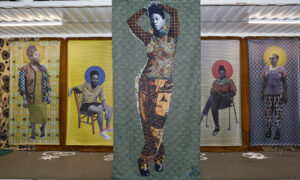
On Saturday, December 4, our art gallery will be decked out in dazzling portraits of local Black figures, Liberation leaders, and ancestors, created by Philadelphia artist and community organizer Makeba Rainey. Her exhibition, LESS IS MORE: The Nature of Letting Go, will be on display through March 26, and is, as she describes it, “a celebration of a distinctly Black American ingenuity.” Her title refers less to a reverence for minimalism for its own sake than “a call to do the most with the least… as we have always done.”
Bright colors and patterns of African wax cloth frame defiant, determined, and joyful faces in Rainey’s signature portrait style, one that has evolved since time spent in elementary school playing around with Microsoft Paint. While Rainey’s color palette has always been vivid, the framed faces have come more into focus over time and the surrounding patterning more complex—and more distinctly African. Now a self- (and YouTube-) taught expert in Photoshop, Rainey has pioneered a style that’s increasingly popular thanks to a few “high profile commissions (give thanks!)” and especially social media. Her work has inspired many imitators and garnered more than 14,000 Instagram followers. It’s an artistic sensibility she loves because it “is so accessible and has created a visual language with which to express pride in our African-ness.”
Beyond her own visual artwork, Rainey is transforming the gallery into a healing, memorial space, complete with a restorative reading corner for rest and reflection. This reading space is an extension of a project Rainey has been working on for a while now with a Black artists collective she started—the B(A)LM Community Library—and features books curated alongside other Philadelphia-based organizers, educators, and booksellers. Opposite this corner, another gallery wall will be covered in church fans dedicated to recently deceased members of the Philadelphia Black community. Outdoor wall art and seating (look for a swing!) extend the exhibition onto our grounds, and are an invitation to recharge and take solace in nature.
Through this medley of spaces and artwork, Rainey explores how Blacks can access the energy of nature necessary for community and self-sustainability. More particularly, she asks us, how do we harness nature while also living in ethical and resourceful accord with it? Especially in this time of global scarcity—keenly and unjustly felt by those living in already under-resourced communities in our city—what does it look like to live sustainably, to find sustenance in ancestors, neighbors, family, and friends?
In that vein, Rainey’s work is characterized by extensive collaborations with fellow artists, local organizations, and community members. As she puts it, “My community are my collaborators and my collaborators are my community.” For this exhibition, her creative partners include fellow Philadelphia artists Dominique London (creator of Skoolie, a school bus turned into a sustainable tiny home), musician and yogi Sudan Green (of SpiritsUp!) and sound designer Julien Terrell, among others. Together they will provide guided and meditative walks, healing rituals, and sustainable art workshops.
When asked what she looks for in a collaborator, Rainey says “folks who share the same love and compassion that I have for ALL Black people. Folks who are authentic in spirit and diligent in their craft. Folks who are kind and who give more than they take. Folks who are constantly pushing themselves to be and do better. And, probably most important, people who can’t do what I can.” They’re folks who already are or become her family, and who complement each other personally, artistically, and spiritually.
For Rainey, community also extends beyond the living; ancestors are as important as one’s current family, whether blood or chosen. The exhibition—its title and the ethos it reflects—is “an expression of gratitude and reverence for our ancestors,” Rainey says. It’s an exhortation to remember “you are who they were. Nothing more. Nothing less.” That’s why she’s covering one wall with church fans featuring photos of the recently deceased. Not only do church fans hold a particular place in Black culture, for Rainey they also help in “imagining their [an ancestor’s] spirit as the wind sweeping over you. Imagine them with you in your moments of respite and of praise… because they are. They are with you always.”
We will celebrate the exhibition’s opening at 2:00 p.m. on Saturday, December 4 with a restorative walk through the Center’s grounds, a ceremonial drink, and conversation between the artist and cultural worker and healer Hakim Pitts. They’ll discuss the exhibition’s inspirations, Rainey’s printmaking process, working with nature, and building community. “When you work with/for the people you love and who love you back,” Rainey says, “the work will always be good.” Please register for the free event.
LESS IS MORE is presented by the Schuylkill Center’s Department of Environmental Art.
By Emily Sorensen, Exhibitions Coordinator.
